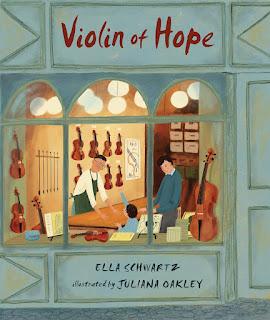Ella Schwartz is the author of the new children's picture book Violin of Hope. Her other books include Her Name was Mary Katharine. She lives on Long Island, New York.
Q: What inspired you to write Violin of Hope?
A: I am the granddaughter of Holocaust survivors. As an author, I always wanted to write a story to honor my grandparents, but Holocaust books for young readers are tricky. None of my story ideas struck the right chord.
I can’t even count how many concepts and half written books I discarded over the years. All of them didn’t feel like a fitting tribute to my grandparents and other Survivors.
When I heard about the real-life organization Violins of Hope, I was deeply inspired by their work. Their mission was just the right backdrop for the story I had always hoped to tell; one of family, legacy, traditions, and hope.
Q: How did you research the book, and did you learn anything that particularly surprised you?
A: I am not a violin player, but I had to become a luthier in training! I learned all about violin construction, the parts of a violin, and the craft that luthiers use to build, repair, and tune these instruments.
Violin construction is based on science and engineering, and I am an engineer by career and education, so this was an exciting new research opportunity for me.
I’ve always loved the music of violins and researching this book inspired me to take up learning to play! I hope my family will be patient with me as I fumble through the learning experience.
Q: What do you think Juliana Oakley’s illustrations add to the story?
A: Feiga and Itzik, characters in the book, are inspired by my grandmother and grandfather, survivors of the Holocaust. When Juliana joined the project, I sheepishly gave her a photo of my grandparents. I wanted to give her an idea of the period and the backdrop of the story, but also introduce her to the real-life Feiga and Itzik.
When I first saw Juliana’s drawings I was profoundly moved. Not only did she capture the period so beautifully, but I saw flashes of my grandparents.
The expression on Papa’s face or the way Mama puts her hand on her daughter’s shoulder; somehow Juliana captured not only the spirit of Jewish families in Eastern Europe during WWII, but also the essence of my grandparents.
Q: What do you hope kids (and adults) take away from the book?
A: People say “Never Forget” but the Holocaust happened over 80 years ago, so it’s easy to forget, especially as the number of Survivors are sadly dwindling. As the descendant of Survivors, I feel it is my responsibility to remember.
I hope my book will not only help readers remember but will also provide inspiration. At its core, this book is about family, traditions, and legacy and these are themes that extend beyond Holocaust education. I hope readers will reflect on their own family legacies.
Q: What are you working on now?
A: I’m deep in the research trenches for a new project about a largely unknown but inspiring Civil War hero. Stay tuned!
Q: Anything else we should know?
A: Since this book is dedicated to my grandparents, your readers may be interested to know that when I was growing up, my grandparents lived with us in the same house.
Even though I lived with my grandparents until they passed away, I never knew their stories. We all knew my grandparents had been through the Holocaust, but nobody in the family asked questions. We worried the memories would be too painful.
It wasn’t until I was an adult that I became curious about my roots and started researching my grandparents’ journey through the Holocaust. Uncovering my family’s dark past was painful but important. Now, as a Holocaust educator, I get to tell my grandparents’ story. Finally, the story that was buried for so long is no longer a secret.
--Interview with Deborah Kalb. Here's a previous Q&A with Ella Schwartz.


No comments:
Post a Comment